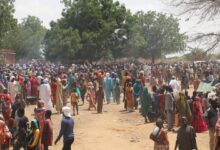2024 deadliest year ever for aid workers, UN humanitarian office reports
 The death toll of humanitarian workers in 2024 has become the “deadliest on record”, with 281 killed globally, the UN humanitarian affairs office, OCHA, reported on Friday.
The death toll of humanitarian workers in 2024 has become the “deadliest on record”, with 281 killed globally, the UN humanitarian affairs office, OCHA, reported on Friday.
The grim milestone has surpassed previous records.
“Humanitarian workers are being killed at an unprecedented rate, their courage and humanity being met with bullets and bombs,” said Tom Fletcher, the new UN Under-Secretary-General for Humanitarian Affairs and Emergency Relief Coordinator.
Tweet URL
“This violence is unconscionable and devastating to aid operations,” he added.
Gaza conflict drives surge in deaths
The war in Gaza has driven the surge in casualties, with at least 333 humanitarian personnel killed since October 7, 2023. Most were staff members of the UN Relief and Works Agency for Palestine Refugees in the Near East (UNRWA).
According to the latest entry in the Aid Worker Security Database, 10 national staff were killed in Gaza this month alone.
“These numbers today will no doubt send shockwaves around our humanitarian community, especially on the front lines of the response,” OCHA spokesperson Jens Laerke told reporters on Friday at a briefing in Geneva.
He noted that the vast majority of casualties are national staff working for UN agencies, non-governmental organizations (NGOs) and the Red Crescent and Red Cross movement, with 268 national staff and 13 international staff killed.
Threats to aid workers globally
As conflicts continue to escalate worldwide, the dangers facing humanitarian workers have intensified beyond Gaza.
“They are working courageously and selflessly in places like Gaza, Sudan, Lebanon, Ukraine and other conflicts,” Mr. Laerke said, noting that with 2024 not yet over, the death toll has already surpassed last year’s record of 280 deaths.
“Threats to aid workers extend beyond Gaza”, he noted, explaining that there are “high levels of violence, kidnappings, injuries, harassment and arbitrary detention reported in Afghanistan, the Democratic Republic of Congo, South Sudan, Sudan, Ukraine and Yemen, among other countries”.
The cost of international violence extends beyond statistics. “Being national humanitarian staff does not make them foreigners to us – it makes them colleagues and often friends,” Mr. Laerke emphasised.
“They show the best interest humanity has to offer. And they are getting killed, in record numbers, in return”.
Prevent attacks, enhance protection
The violence against aid workers also reflects a broader pattern of civilian harm in conflict zones. Last year saw more than 33,000 civilian deaths in 14 armed conflicts – a 72 percent increase from 2022.
Despite these challenges and dangers, humanitarian organizations continue to deliver vital assistance, reaching nearly 144 million people in need last year.
In response to this crisis, the UN Security Council adopted Resolution 2730 (2024), which mandates the Secretary-General to recommend measures to prevent attacks on aid workers and enhance protection for humanitarian personnel.
These recommendations will be presented at a Security Council meeting on 26 November.
“States and parties to conflict must protect humanitarians, uphold international law, prosecute those responsible and call time on this era of impunity,” Mr. Fletcher concluded.



